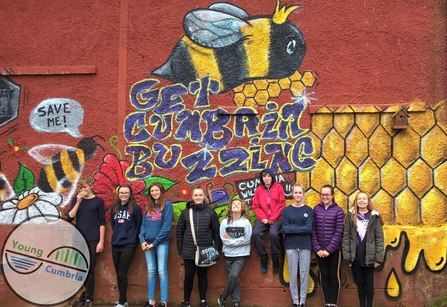
© Cumbria Wildlife Trust

© Cumbria Wildlife Trust
Set against a backdrop of an ever increasing threat of climate change, and recent news from the UN that global extinction has accelerated by at least a 20% loss of species over the past 100 years, the funding will enable local communities to work side by side with researchers and conservationists on flagship projects to save and protect bees, wild pollinators and threatened species on a scale not seen before.
Back on Our Map (BOOM) in South Cumbria is a £2m, four-year University of Cumbria project supported by £1,056,429 from National Lottery Heritage Fund to reintroduce ten threatened species of native flora and fauna across the lowlands of Morecambe Bay to get them back on our map. The project also aims to work towards reintroducing the Cumbrian corncrake and pine marten to the region.
Three animals (hazel dormouse, Duke of Burgundy/small blue butterflies), and seven plants (Goldilocks aster, greater and oblong sundew, green-winged orchid, maidenhair fern, spiked speedwell, and aspen) are to be reintroduced to their habitats.
BOOM aims to champion local custodianship of nature as part of the project by offering a wealth of training opportunities in horticulture and conservation from species handling and breeding, to surveying, habitat management and planting techniques. 145 people will be trained as part of the project and the team will work with local communities including young people and prisoners at HMP Haverigg. There will also be opportunities for families to get involved through species walks and talks, nature and art competitions and classes culminating in an exhibition.
BOOM will be delivered in partnership with Morecambe Bay Partnership, Cumbria Wildlife Trust, Natural England and The Forestry Commission.
Get Cumbria Buzzing in North West Cumbria aims to get parks, school grounds and other green spaces around Workington, Whitehaven and Maryport buzzing with bees and pollinators thanks to £912,800 funding from the National Lottery Heritage Fund. The ground-breaking project will see Cumbria Local Nature Partnership work with Highways England and Cumbria Wildlife Trust to get local people buzzing with activity to boost numbers of bumblebees and other wild pollinators and halt their decline.
Britain is home to an amazing variety bumblebees, hoverflies, solitary bees, butterflies and moths but their homes and food sources are under threat. Modern agriculture and increased urbanisation of towns and villages is seeing a major loss of habitats on which pollinators depend. Amazingly, they help to provide one third of the food we eat, are a natural pest control, and feed much of our wildlife while being responsible for a wide diversity of plants worldwide. Just 1 to 2% of flower-rich habitat in a landscape, or even a garden or park, is enough to have a significant impact on populations of wild bumblebees.
This three-year project will create, restore, and enhance 115 hectares of pollinator friendly habitat at 62 sites in North West Cumbria by connecting and restoring flower-rich habitats along ecological networks known as B-Lines. The project is dependent on volunteers for its success and opportunities for people to make a buzz include everything from gardening workshops to themed arts and crafts events, pollinator training courses to conservation days, educational workshops linked to the curriculum and many many more.
David Renwick, Area Director for the North, National Lottery Heritage Fund, said:
“These two projects really are the bees knees for Cumbria, particularly as we’ve prioritised nature for the next five years. Both will see vital work undertaken through powerful partnerships with biodiversity organisations and local people – ensuring that important wildlife in decline is put back on our map thanks to money raised by National Lottery players.”
Ian Convery, Professor of Environment and Society at the University of Cumbria and Co-Chair of the International Union for Conservation of Nature (IUCN) Rewilding Task Force, said:
“Community involvement is vital, as it will not only benefit individual species, but also acts as a catalyst for engaging communities in the wider environment with positive outcomes for biodiversity, the local economy and wellbeing. This is highlighted in the government’s 25 year Environment Plan as a key action to reverse the ongoing decline in biodiversity. We are looking forward to working with our community partners, alongside project partners to bring this exciting and transformative project to life.”
Tanya St.Pierre, Get Cumbria Buzzing Project Manager, Cumbria Wildlife Trust, said:
“We’re absolutely delighted! This funding allows us to create much-needed pollinator-friendly havens and wildflower highways, providing a lifeline for our bumblebees, butterflies, hoverflies and other pollinating insects. By transforming green spaces and working closely with communities, we aim to get Cumbria buzzing again. Everyone can help - please get in touch!
The project wouldn’t be possible without the support and generosity of our partners and additional funders including Allerdale Borough Council, Buglife, Butterfly Conservation, Copeland Borough Council, Cumbria Biodiversity Data Centre, Cumbria Community Foundation, Cumbria Waste Management Environment Trust, Florence Arts Centre, Highways England, National Trust, Solway Coast AONB and Workington Nature Partnership.”
Dion Auriac, Project Manager at Highways England, said:
“Our roads connect communities across England and we’re committed to making sure our work supports the local economy and environment. That’s why we’re pledging £860,000 from our environment designated fund to the Get Cumbria Buzzing scheme to trial an innovative approach to managing verges on the A66 and A595 in Cumbria. We’ll be changing our grass-cutting and roadside maintenance systems to create habitats that provide food, shelter and nesting sites to help bees and other wildlife thrive alongside Cumbria’s major roads.”

© Cumbria Wildlife Trust